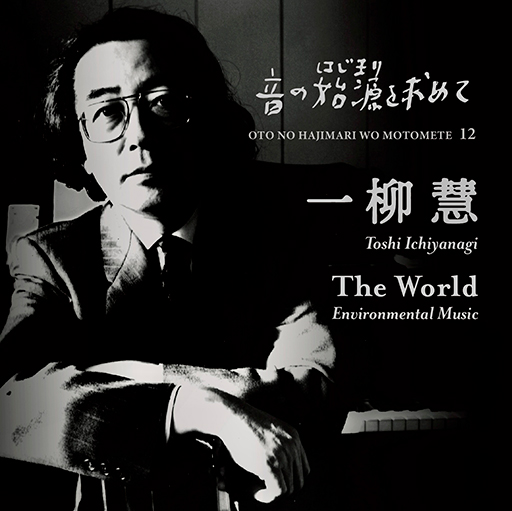
音の始源を求めて 12
一柳慧
The World
Environmental Music
The Beginnings of
Japanese Electroacoustic Vol.12
TOSHI ICHIYANAGI
The World
Environmental Music
Disc 1
- 《パラレル・ミュージック》 1962年
“Parallel Music” 1962 - 《空》 1965年
“Kū” 1965
Disc 2
- 《東京 1969》 ver.2 1969年
“Tokyo 1969” ver.2 1969 - 《生活空間のための音楽》 1970年
“Music for living space” 1970 - 《The World》 1975年
“The World” 1975
内容紹介
- Disc 1
- 1.「パラレル・ミュージック」 (1962)
- NHKは新橋にありスタジオは電子音楽室と呼ばれていた、モノラル・ラジオの時代作品。
1962ジョン・ケージショックの最中、チャンス・オペレーションで環境音楽を制作!芸術祭参加作品。
創作の過程で生まれる様々な素材を並列的(パラレル)に配置したテープミュージック。 - 2.「空」(1965)
- 完成されなかったオペラのために作られた電子音楽。超高音波の放射や、爆発する椅子、演者も観客も巻き込んで、
動的な混沌を目論んだ「環境音楽オペラ」60分バージョンを今回初公開。 - Disc 2
- 1.「東京 1969」ver.2 (1969)
- 時代はラジオFMステレオの時代。NHKは神南に移転し、電子音楽スタジオの設計コンセプトも変わり名称も電子音楽スタジオに。
当時ラジオや巷に流れていた音楽、落語、ニュースの他、日本でも始まったばかりのロック音楽を不規則に配置。
不確定現象を持った電子音を音楽の中へ取り込むことが作曲上のアイデアであった。 - 2.「生活空間のための音楽」 (1970)
- 1970年開催の日本万国博覧会「太陽の塔」を中心とした「テーマ館」の空中展示の内「生活」区画のための音楽
京都大学電子工学部が制作したコンピューターによる合成音声で黒川紀章の未来建築のマニフェスト
「カプセル宣言」や粟津潔の「デザイン論」川添登の「建築論」が朗読され、グレゴリア・チャントと歌謡曲が流れていた。 - 3.「The World」 (1975)
- 東京1969の姉妹編。<環境>的な動機が構想の基本になっている。音・光・風・温度・湿度など
自然と人口の環境の変化を音に変換していく作業をロケで行い、自然環境の偶然の作用を取り込みながら制作された作品。
多様な音楽と音響を混ぜ合わせ、予期できない自然の作用を取み入れることによって、有機的で動的な<環境>を作り出した作品。
Introduction
- Disc 1
- 1. “Parallel Music” (1962)
- The monaural radio period work, which was created while NHK was located in Shimbashi, and the studio was called the electronic music room.
In the midst of the John Cage shock of 1962, he produced environmental music at Chance Operation! He participated in an art festival with this work. A tape music piece in which various materials created in the process of creation are arranged in parallel. - 2. “Kū” (1965)
- Electronic music created for an opera that was never completed. It involved the radiation of super-high sound waves,
exploding chairs, and both the performers and the audience.
This “environmental music opera” is designed to create dynamic chaos. 60-minute version is publicly performed for the first time. - Disc 2
- 1. “Tokyo 1969” ver.2 (1969)
- In the age of radio FM stereo, NHK moved to Jinnan, and the design concept of the electronic music studio and the name was changed to Electronic Music Studio.
In addition to the famous music at that time, Rakugo (comic storytelling), news, rock music, which had just started to spread in Japan, were arranged in irregulary.
The idea of the composition was to incorporate electronic sounds with indeterminate phenomena into the music. - 2. “Music for living space” (1970)
- Music for the "Living" section of the aerial exhibition in the “Theme Pavilion”
centering on the “Tower of the Sun” at the Japan World expo in 1970.
A computer-generated synthetic voice produced by Kyoto University's Faculty of Electronic Engineering
read Kisho Kurokawa's “Capsule Manifesto,” a manifesto for future architecture,
Kiyoshi Awazu's “Design Theory,” and Noboru Kawazoe’s “Architecture Theory,” while Gregorian chants and songs were played. - 3. “The World” (1975)
- A sister piece of Tokyo 1969. The conception was based on an “environmental” motive.
The work was created on location, transforming sound, light, wind, temperature, humidity,
and other changes in the natural and artificial environment into sound, while incorporating the accidental effects of the natural environment. By mixing a variety of music, sound, and incorporating unexpected natural effects, the work created an organic and dynamic “environment”.
BUY
- Official Online Shop
- https://sound3.buyshop.jp/items/78457047
- CDに関するお問い合わせ
- denshi-ongaku@sound3.co.jp
Manufacture Distribute by Sound 3 Co., Ltd. (P)2023
制作/有限会社 サウンドスリー
企画/大阪芸術大学音楽工学OB有志の会
Sound 3 Co., Ltd.
#404 Style House Ebisu 3-34-14 Ebisu Shibuya-ku Tokyo Japan zip 150-0013